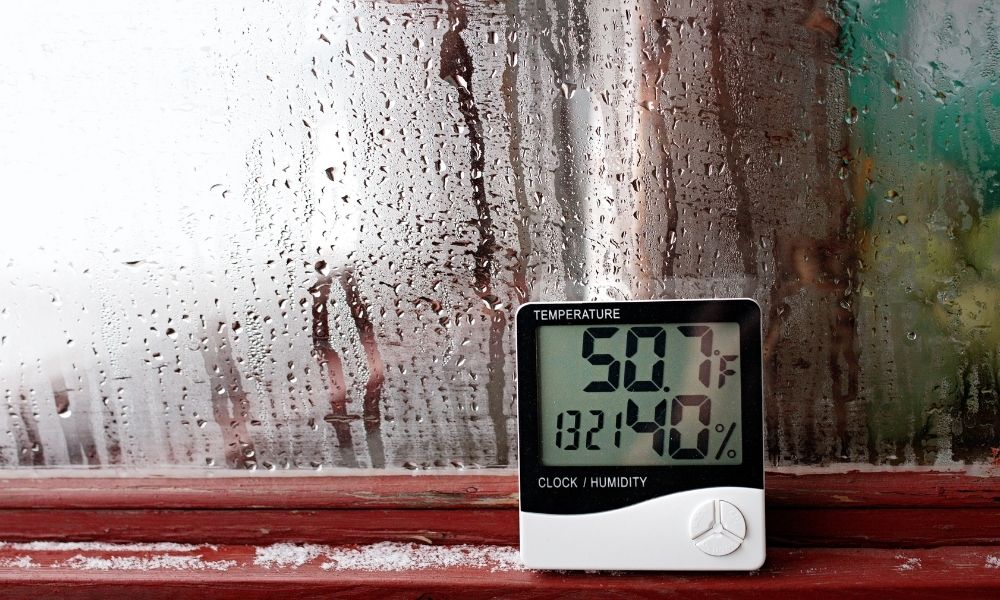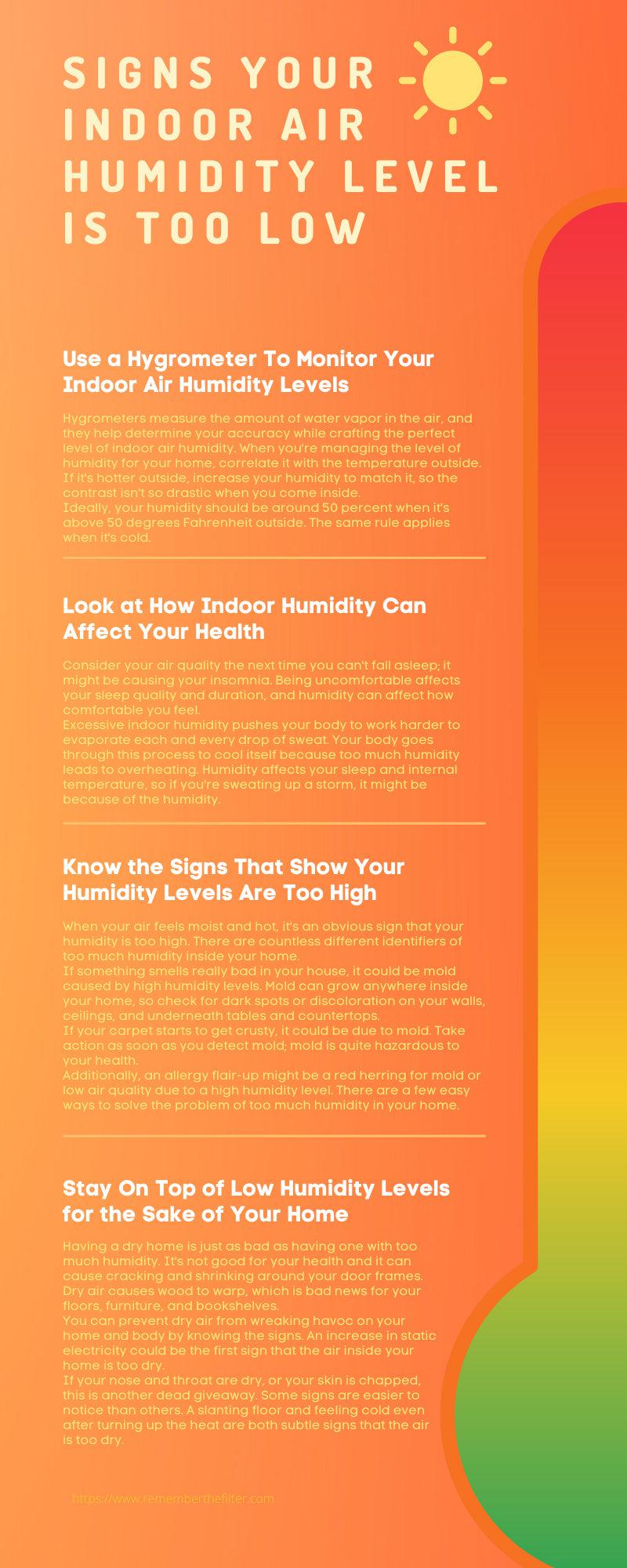1-866-469-8556
1-866-469-8556
1-866-469-8556
1-866-469-8556

As a homeowner, you want people to feel comfortable and safe when they visit you. However, that all comes into jeopardy when your humidity level compromises your indoor air quality. The humidity level inside your home can significantly impact how comfortable you feel when you're indoors.
When your humidity is too high or low, not only does it compromise your health, but it also causes problems for the house itself. You might be wondering what level of humidity is ideal for the inside of someone's home. Although it varies, you generally want your indoor humidity level to be around 30 to 50 percent for maximum comfort.
For your safety and wellbeing, you need to monitor your indoor humidity level closely. In this article, you will learn the telltale signs your indoor air humidity level is too low and how to get back on the right track.
In order to reach that sweet spot between 30 and 50 percent humidity inside your home, you need to measure your indoor air humidity levels accurately. Luckily, this task is not too difficult.
However, there is a crucial tool that you need to carry out this action. That tool is the hygrometer, and they are not too costly, either. Hygrometers are available online and at your local home goods retailer for around $20.
Hygrometers measure the amount of water vapor in the air, and they help determine your accuracy while crafting the perfect level of indoor air humidity. When you're managing the level of humidity for your home, correlate it with the temperature outside. If it's hotter outside, increase your humidity to match it, so the contrast isn't so drastic when you come inside.
Ideally, your humidity should be around 50 percent when it's above 50 degrees Fahrenheit outside. The same rule applies when it's cold.
Lower your humidity to below 20 percent when it's over 10 degrees below zero. Use your best judgment for anything in between but remember that keeping humidity between 30 and 50 percent works best for most days.
You can't prevent your humidity level from being off-balance if you don't know what the signs are when things go wrong. The three most prevalent signs that your indoor air humidity level is too low or high are when it's difficult to breathe, you are sweating profusely, or you're having a tough time sleeping.
Consider your air quality the next time you can't fall asleep; it might be causing your insomnia. Being uncomfortable affects your sleep quality and duration, and humidity can affect how comfortable you feel.
Excessive indoor humidity pushes your body to work harder to evaporate each and every drop of sweat. Your body goes through this process to cool itself because too much humidity leads to overheating. Humidity affects your sleep and internal temperature, so if you're sweating up a storm, it might be because of the humidity.
On the contrary, air that is too dry is an irritant to your throat and sinuses. Dry air can negatively impact how it feels when you clear your throat or even breathe, and it can lead to a coughing fit. Thus, you must take action if you find it difficult to breathe.
Asthma symptoms are very similar to what it feels like when exposed to high levels of humidity. If the air feels thinner, you find yourself breathing harder and more often, and you are wheezing nonstop, it could be due to humidity.
When your air feels moist and hot, it's an obvious sign that your humidity is too high. There are countless different identifiers of too much humidity inside your home.
Another example is when your windows get foggy, especially when it's hot outside. They get foggy because of the air's excess moisture, which can compile and create mold or mildew.
If something smells really bad in your house, it could be mold caused by high humidity levels. Mold can grow anywhere inside your home, so check for dark spots or discoloration on your walls, ceilings, and underneath tables and countertops.
If your carpet starts to get crusty, it could be due to mold. Take action as soon as you detect mold; mold is quite hazardous to your health.
Additionally, an allergy flair-up might be a red herring for mold or low air quality due to a high humidity level. There are a few easy ways to solve the problem of too much humidity in your home.
First, turn on your air conditioner and change the filter on a consistent schedule. If you forget to change your filter regularly, dust and other pathogens can build up inside it, resulting in poor indoor air quality. Look at air conditioning filters online to find the right filter for your system.
Also, use fans when you are showering or cooking to prevent excess moisture from piling up. Your gutters are another breeding ground for excess moisture, so clear them out when it's time. Other solutions include purchasing a dehumidifier as a standalone unit or installing one in your HVAC system and separating all your houseplants if they are in the same location.
Having a dry home is just as bad as having one with too much humidity. It's not good for your health and it can cause cracking and shrinking around your door frames. Dry air causes wood to warp, which is bad news for your floors, furniture, and bookshelves.
You can prevent dry air from wreaking havoc on your home and body by knowing the signs. An increase in static electricity could be the first sign that the air inside your home is too dry.
If your nose and throat are dry, or your skin is chapped, this is another dead giveaway. Some signs are easier to notice than others. A slanting floor and feeling cold even after turning up the heat are both subtle signs that the air is too dry.
Purchasing some houseplants is an easy remedy for dry air, but a humidifier will also do the trick. Furthermore, leaving the bathroom door open while the shower's running and boiling water without a lid both add moisture to a dry room.
Overall, the home is where the heart is, so don't let poor indoor air quality ruin the place you love most. By watching out for all the signs your indoor air humidity level is too low, you can keep everyone in your home happy and healthy.
Regular replacement of air filters is essential for maintaining a healthy indoor environment, particularly in relation to humidity control. Over time, air filters accumulate dust, allergens, and other particulates, which can impede airflow and reduce the efficiency of your HVAC system. This inefficiency can exacerbate issues related to indoor humidity, leading to either overly dry or excessively humid conditions.
High-quality air filters from RememberTheFilter.com not only ensure cleaner air but also contribute to the optimal functioning of your HVAC system. This, in turn, supports the maintenance of desired humidity levels. By choosing the right MERV (Minimum Efficiency Reporting Value) rating, you can balance air quality with humidity control. For instance, a higher MERV rating offers finer filtration, capturing more particles and potentially assisting in keeping the indoor air at a comfortable humidity level.
Remember, changing your air filters regularly is not just about air quality; it's also about creating a balanced and comfortable indoor environment. With RememberTheFilter.com's diverse range of high-quality air filters, you can easily find the perfect fit for your needs, ensuring your home remains a healthy and comfortable space.
Visit Best Sellers
{"one"=>"Select 2 or 3 items to compare", "other"=>"{{ count }} of 3 items selected"}
Leave a comment